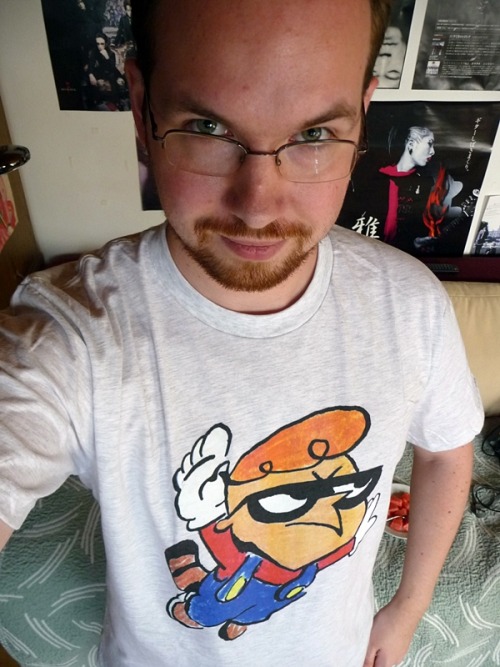-
Content Count
245 -
Joined
-
Last visited
Posts posted by Umi_Niwa
-
-
-
-
I can see this in a shoujo anime opening about time travel super power type of thing or something.
-
DistraughtK is a Bieber fan.
-
Even if lyrics are translated properly, they still cannot bring forward a message that the lyricist might have meant originally. Japanese and English are interpreted in complete different ways, and in my eyes it almost impossible to transfer the exact meaning.
True, but even if you are fluent in Japanese you can't make crappy lyrics make sense when they didn't make sense to begin with. And I've been reading multiple translations of the same song. Though I'm not an expert of course, lol.
-
^ I love that song xD The pv is kinda predictable, although the colors are nice indeed.
Here are two more pvs I like. Not Visual-Kei though. These are by Acidman.
http://youtu.be/6X8OiZgOCQo
I was quite moved by this one, I think it makes even stronger impact with the song being instrumental.
http://youtu.be/nHoWPc8inpk
Love the song and the desert village setting (I'm assuming it was shot somewhere in Morocco). -
Ban the person above me because he doesn't know anything about me
-
Fina is Finnish

-
-
Hello and welcome!
 Nice to see another fellow NoGod fan
Nice to see another fellow NoGod fan 
-
-
Ban the person above because he's always butting in.
-
I think Satsuki's Crystal would be perfect for an anime opening (if it hasn't been used already =P).
-
Lol I was a fan for a while when that whole thing went down, and I know a lot of the fandom was really worried that he would drop out of the music scene because of it.
I dont think I could handle losing a voice as awesome as his!
Me too
 I think he's an awesome person too.
I think he's an awesome person too. -
The Hora awesomeness <3
-
A lot of times when I read lyric translations to a song the first thing that crosses my mind is wtf were they thinking writing this nonsense? Sometimes it's so weird or hilarious the whole song loses its effect for me. I could give only so many examples.
-
I hope they get all this solo crap out of their system...honestly, if you're still going to work together on every project ---you might as well just form Deluhi again with 3 members...xTRiPx has only 3 members now AND they are killing with their music! I'm pretty sure Deluhi as a 3 piece would do just fine.
My thoughts exactly.
-
Im really so so so happy that this band is still around, I dont even remember how I came across them.
On youtube somehow, but i just know that I instantly fell in love.
Even after all the shit that went down with danchou, Im happy that they've been able to move past it and keep on going instead of disbanding and leaving a void in my heart
*emoemo*
I love Dancho more because of that believe it or not
 (although I discovered them much after the whole incident and only found out about it from some random tumblr post).
(although I discovered them much after the whole incident and only found out about it from some random tumblr post). -
To be honest I haven't heard anything from the ex-Deluhi members solo projects to really catch my attention. I wonder if this is gonna be different. Either way I'm curious.
-
Since I can't stand the Mejibray/GazettE-stanning that's taken over this topic and has gotten away from the original intent, I'm bringing it back. I'm also giving you all something new to talk about since new unpopular opinions have ceased to surface over the last page or so.
Visual kei is not a genre or an aesthetic movement. It's a paradoxical manifestation of an anomaly against the negatives of Japanese culture.
This is closely related to the problem of "what is visual kei?".
Stolen shamelessly from Wikipedia, a genre is defined as
We can stop right here. Before you start processing the definition, ask yourself "what is visual kei"? We can have a ten page discussion about that in this topic right now and still not come to a consensus. Visual kei is an open-ended, ill-defined term exploited by both us and the bands in the scene to refer to whatever we please. We agree to disagree on what the term is supposed to mean and take it at face value when someone tells us that a band is or isn't visual kei anymore.
By definition, visual kei can't be a genre because we can only define it by what it is not, and very conservatively at that. The difference between newbies and veterans in the scene mostly comes down to context sensitivity determining band classification. What do I mean by this? Well, we can all look at a band or an idol group and very clearly say "this is not visual kei". But if we look at a visual kei band next to a band that uses theatrical make-up and aesthetic elements, we get into murky territory. Sometimes it is, sometimes it isn't. Newbies lack the knowledge to make this distinction, and utilize only the looks to say whether or not a band is visual. Then, they get lashed upon by fans of that band who "don't want to associate this band with those bands" for getting it wrong, and they learn. Eventually they learn only to label a band as visual kei if they describe themselves as such or if someone else before them says it first. [1]
The thing is, the newbies have the right approach at first. They get into the scene, they hear that it's a genre, and seek to classify it. But before long they realize that over the span of twenty years, visual kei has birthed bands that sound very, very different. Going off of sound alone, all bands that were ever considered visual kei can't be connected short of a definition so vague it's useless. So then we turn to the costumes and theatrics and claim that as a large component of what makes a band visual. But even there, we can piece together different bands that don't look anything alike - some bands which don't look remotely visual at all - and claim they are all visual kei. Hell, lynch. has looked like a normal band for quite some time and there's still a heated debate to whether or not they're visual kei. On the first page of this very topic, one of the unpopular opinions was that "Dir en grey is still visual". Once again, you now have bands that have very little in common aesthetic wise and short of a very vague, useless definition we have nothing to go off of.
So I've basically run through this problem, haven't given a solution and haven't explained my point (or have I?). What gives?
Well as a fandom we tend to separate visual kei bands based on decades, so let's do that:
- The mysterious late 80's, which most of us like to pretend doesn't exist, full of bands that play some form of rock or metal.
- The music of the 90's, which is usually thought of as bands inspired by Victorian and goth costumes playing...well, whatever they want.
- The 00's, which was populated by lots of flashy costumes, usually subdivided into subkeis to better be able to classify and understand bands but still full of bands playing whatever they want.
- The 10's, which seems to have a preponderance of electronic elements in the music but for the most part still full of plenty of different bands playing whatever they please.
And even here we tend to simplify this as to "80s HAIR METAL, 90'S GOFF MUZIK, 00'S KEI ON KEI ACTION/RAWRCORE, 10'S WUB-WUBCORE", which illustrates the points I made above. As a fan, you get to a point where you realize that the term can't be defined and thus you stop. The working definition is "If a band wants to be visual kei, they'll be visual kei. When they don't, they're no longer visual kei". [2] So doesn't this describe a movement, which brings together people just as different for a common cause? Let's go through all of the things that should make a movement and see if it lines up.
Well let's see:
- Coordinated group action. Well, visual kei isn't very rebellious or subversive, outside of the low barrier to entry being offensive to some people's ears and the costumes being offensive to some people's eyes. Unless there is this entire "point" they all share that we've missed for forever and a day, I believe that most bands focus on staying functional over staying Stallman-esque in their beliefs. [3] And frankly, I can't blame them. Pragmatism rules. [4]
- A common cause. But what is that cause and do all bands share it? As I said above, we really don't think of visual kei as something as much as we do as an entity against something. But even that "entity" changes over time, reflected by the different forms of visual kei. So do the bands of the late 80's and the bands of today share the same goal? Yes and no. [5]
- People from different walks of life. We can't say too much because we don't know the details of most musicians. Note however that on a macro scale most visual kei bands are Japanese and many tend to gravitate around a few cities on the mainland. We also can surmise that a lot of these musicians are poor or struggling. We also haven't seen the scene take root in any other countries with similar situations. In this sense, it represents a truly Japanese problem - disillusioned youth versus "The System". If it's a movement here, it's on a small scale.
Visual kei is too anti-classification to be a genre and too inconclusive to be a movement. So what is it?
My admittedly semantic description of visual kei is that of a paradoxical anomaly. It exists, full of people perpetuating it unaware of it's purpose, fighting against an issue that plagues the Japanese society whilst embodying almost every characteristic of that society. What is that issue? Well, I believe the issue lies in the extreme conformity and deference to authority found in the society, coupled with high expectations placed upon every member of that society, along with a thirty year recession that has stagnated the Japanese economy and makes it hard to achieve the life every Japanese person feels it is their duty to obtain.
A strictly Japanese problem. [6]
Visual kei exists as an antagonist to everything in that society, even definition, because it refuses to conform. It's piloted by people who know full they may never see success but toil anyway as a gigantic "FUCK YOU" to their society. It's also mostly populated by young people with the drive and ambition to change their surroundings but no means to achieve that change (and older people who exploit these young people for the cash they'll never see, bringing the entire scene into territory so meta it hurts). When those kids grow up and lose their drive, as after years of fighting against this nebulous problem they watch it shift into something new but no less harmful, they give up, slip into the routine, and become working salary men that can't be identified. It's an anomaly that just is, and that anomaly happens to make noise that we like to listen to.
To pigeonhole visual kei into anything else misses the political and cultural significance that caused it's birth.
tl;dr - Visual kei is the Japanese "hippie culture" of the 60's, with no Vietnam War in sight to bring it to an end. [7]
Notes:
Here I extrapolate on points that I wanted to make above and didn't because I didn't want to go on a tangent and not come back.
[1] This is my personal belief behind why revival bands like Grieva and Ru:natic will never see a resurgence. The forms that visual kei took in the 90's was in resistance to the culture and expectations of the 90's. The world is an irreversibly different place and thus visual kei must change along with it. This is also why I believe that visual kei is not an aesthetic - the fashion world moves in cycles much shorter than 30 years. Visual kei hasn't repeated a phase to date. That's why I believe it supersedes such a definition.
[2] Not only does this loose definition work but it reflects a lot of what I get into later in my argument. Most importantly, that it gives an element of control back to the band. I've read in multiple places that the Japanese populace don't feel like they have much choice - they must succeed in school, get into better schools, succeed there, get a good job, start a family, etc. - and then must face a wall of depression when they realize that most can't get to the head of the pack and they didn't. By sticking to this definition, bands can have a say in a core element which defines them.
[3] Richard Stallman, founder of the GNU Project. Read up on him to see what ideals unbounded by pragmatism really is. Hint: it sounds like crazy.
[4] When bands have no motivation or have run out of reasons to continue they sometimes disband for no reason. On the other side of that coin, some bands are so tight knit that they feel as if they can't function if a member leaves. But at the heart of it all, many bands don't put ideals and beliefs over success. Those that have them use them alongside the visuals and their music - and even then if it becomes too hard they quit or if they become successful they tone it down or cut it out completely. See, NoGoD.
[5] Even more interestingly, visual kei itself tends to conform in ways, which subverts the point of the whole thing. It's like a military group led by a dictator attacking a dictatorial government for its evils. This is why I refrain from calling it a movement, because it itself embodies the very principles it seeks to combat.
[6] Which is why "overseas visual kei" will never take off. The societal conditions are not right for it to spawn. YOHIO and Seremedy are second-order simulacra.
[7] After WWII, Japan isn't allowed to have a real standing army so it isn't in it's best interest to get into conflicts. I meant it literally. In another sense, you could say that the counterculture of the 60's was against "The System" but manifested itself through the War. Once the War ended, the culture had little reason to exist. Since visual kei doesn't have such a clear cut enemy, it will continue on for much longer. This is also why visual kei can't "die".
You make interesting points there. But now I can't help feeling more confused.
And it's contributed by the fact that it's kinda hard to judge the bands' "ideology" on the context level given the fact that not all of us understand Japanese, and some bands making it even harder to understand what they actually sing about with all the word play they do. So it's all pretty much given to interpretation.
-
I want to sleep grrr....

-
a. I honestly don't understand why some bands are famous. It's something I feel about all music genres but in Visual Kei I ask myself that twice as much.
b. It's nice to see that not all VK/Jrock artists look like models. And it pisses me off when people say "he's ugly and he needs that makeup" or stuff like that. Personally I like to see Jrockers who actually look normal every now and then. -
-





SONG OF THE DAY! ^__^
in Global Music General Discussion
Posted
lolita23q 絶対永久クリスタル (
I found this song randomly somewhere and I fell in love with it.
Unfortunately I don't have a sample to play but you can find it for download.